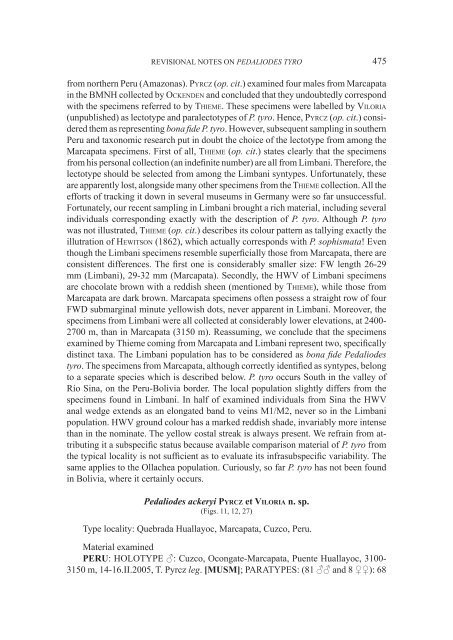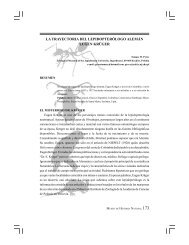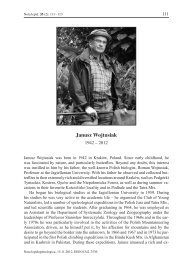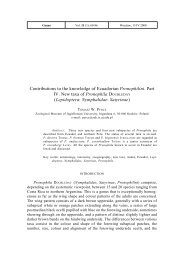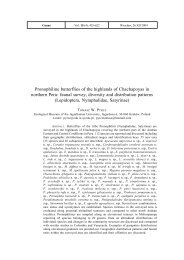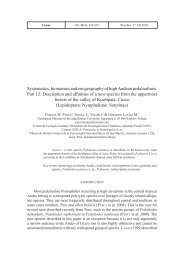Systematics, bionomics and zoogeography of high Andean ...
Systematics, bionomics and zoogeography of high Andean ...
Systematics, bionomics and zoogeography of high Andean ...
Create successful ePaper yourself
Turn your PDF publications into a flip-book with our unique Google optimized e-Paper software.
Revisional notes on Pedaliodes tyro<br />
475<br />
from northern Peru (Amazonas). Pyrcz (op. cit.) examined four males from Marcapata<br />
in the BMNH collected by Ockenden <strong>and</strong> concluded that they undoubtedly correspond<br />
with the specimens referred to by Thieme. These specimens were labelled by Viloria<br />
(unpublished) as lectotype <strong>and</strong> paralectotypes <strong>of</strong> P. tyro. Hence, Pyrcz (op. cit.) considered<br />
them as representing bona fide P. tyro. However, subsequent sampling in southern<br />
Peru <strong>and</strong> taxonomic research put in doubt the choice <strong>of</strong> the lectotype from among the<br />
Marcapata specimens. First <strong>of</strong> all, Thieme (op. cit.) states clearly that the specimens<br />
from his personal collection (an indefinite number) are all from Limbani. Therefore, the<br />
lectotype should be selected from among the Limbani syntypes. Unfortunately, these<br />
are apparently lost, alongside many other specimens from the Thieme collection. All the<br />
efforts <strong>of</strong> tracking it down in several museums in Germany were so far unsuccessful.<br />
Fortunately, our recent sampling in Limbani brought a rich material, including several<br />
individuals corresponding exactly with the description <strong>of</strong> P. tyro. Although P. tyro<br />
was not illustrated, Thieme (op. cit.) describes its colour pattern as tallying exactly the<br />
illutration <strong>of</strong> Hewitson (1862), which actually corresponds with P. sophismata! Even<br />
though the Limbani specimens resemble superficially those from Marcapata, there are<br />
consistent differences. The first one is considerably smaller size: FW length 26-29<br />
mm (Limbani), 29-32 mm (Marcapata). Secondly, the HWV <strong>of</strong> Limbani specimens<br />
are chocolate brown with a reddish sheen (mentioned by Thieme), while those from<br />
Marcapata are dark brown. Marcapata specimens <strong>of</strong>ten possess a straight row <strong>of</strong> four<br />
FWD submarginal minute yellowish dots, never apparent in Limbani. Moreover, the<br />
specimens from Limbani were all collected at considerably lower elevations, at 2400-<br />
2700 m, than in Marcapata (3150 m). Reassuming, we conclude that the specimens<br />
examined by Thieme coming from Marcapata <strong>and</strong> Limbani represent two, specifically<br />
distinct taxa. The Limbani population has to be considered as bona fide Pedaliodes<br />
tyro. The specimens from Marcapata, although correctly identified as syntypes, belong<br />
to a separate species which is described below. P. tyro occurs South in the valley <strong>of</strong><br />
Río Sina, on the Peru-Bolivia border. The local population slightly differs from the<br />
specimens found in Limbani. In half <strong>of</strong> examined individuals from Sina the HWV<br />
anal wedge extends as an elongated b<strong>and</strong> to veins M1/M2, never so in the Limbani<br />
population. HWV ground colour has a marked reddish shade, invariably more intense<br />
than in the nominate. The yellow costal streak is always present. We refrain from attributing<br />
it a subspecific status because available comparison material <strong>of</strong> P. tyro from<br />
the typical locality is not sufficient as to evaluate its infrasubspecific variability. The<br />
same applies to the Ollachea population. Curiously, so far P. tyro has not been found<br />
in Bolivia, where it certainly occurs.<br />
Pedaliodes ackeryi Pyrcz et Viloria n. sp.<br />
(Figs. 11, 12, 27)<br />
Type locality: Quebrada Huallayoc, Marcapata, Cuzco, Peru.<br />
Material examined<br />
PERU: HOLOTYPE ♂: Cuzco, Ocongate-Marcapata, Puente Huallayoc, 3100-<br />
3150 m, 14-16.II.2005, T. Pyrcz leg. [MUSM]; PARATYPES: (81 ♂♂ <strong>and</strong> 8 ♀♀): 68


